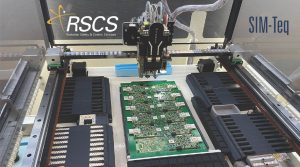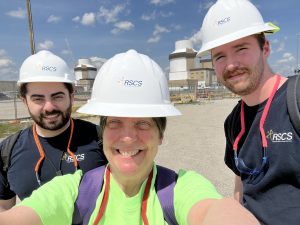
(RSCS Team Outside Vogtle Unit 3)
The call came in on the morning of April 1st, “Tim, Vogtle Unit 3 has synced to the grid”. Tim Rogers, Radiation Safety and Control Services (RSCS) senior Health Physicist, recalls. “I thought it was an April Fool’s joke” states Tim. It couldn’t have been the worse week to suddenly travel to northeastern Georgia as The Masters (The Masters Golf Tournament at Augusta National Golf Club) was starting the next day. “There were no hotel rooms, rental cars, or airline tickets to be had in northeastern Georgia, thankfully one of our team members lived in North Carolina and was able to drive a rental car from there. We found late night flights and hotel rooms near Savannah.” RSCS team members (Tim Rogers, Heather Baxter, and Nate Blouin) gathered suitcases, equipment, and supplies and headed to Vogtle Unit 3 to perform the first neutron characterization measurements on an AP-1000 in the United States.
The purpose of the study was to provide an evaluation for site specific neutron dosimetry correction factors in support of power ascension startups and operations at Vogtle Unit 3. Neutron characterization and correction factor measures have been performed for years for dry fuel storage campaigns, Independent Spent Fuel Storage Installations (ISFSIs pads), and operating nuclear power plants. In 2016, RSCS personnel successfully completed the evaluation for the initial power ascension at TVA’s Watts Bar.
Neutron characterization is important. Most nuclear plants have a variety of fields which have different energy spectrum. Neutron dosimeters respond to the energy curve variations. A site-specific correction factor is needed to address the variation in the response. American Nuclear Insurer’s (ANI) Bulletin 11-02 “Neutron Monitoring” requests utilities evaluate the performance of their personnel dosimetry to neutron radiation fields. These measurements are used to validate dose estimates to workers.
The neutron measurements will be performed on three different containment elevations at locations representative of personnel neutron exposure for three different power levels, 25%, 50%, and 100%. The measurement methodology was developed by RSCS personnel in response to ANI Bulletin 11-02. Each measurement location consists of Dosimeters of Legal Record (DLR) and Neutron Electronic Dosimeters (ED) mounted on a 30 x 30 x 15 cm polymethyl methacrylate (PMMA) phantom. The dosimeters were positioned on a tripod representative of the height of a human torso and measured within the specifications of ANSI N13.11(2009). This configuration allowed for the detection of low-energy albedo neutrons backscattered from the human body.
The PMMA phantoms, with the dosimeters attached, were placed at three site specified locations based upon survey data and representative of location where workers could be exposed to neutron dose. At each site, the DLRs and EDs were placed in the direction of the highest field, typically towards the reactor. The dosimeters were exposed until each dosimeter received approximately 50 mrem of integrated neutron dose equivalent. At the lowest power and location of lowest neutron dose rate, the dosimeters were exposed for 75 hours.
All locations were surveyed for neutron and gammas dose rate using handheld neutron survey meter and ion chamber. All locations were also measured with a Tissue Equivalent Proportional Counter (TEPC) and a neutron survey meter. The TEPC measures mixed-field gamma and neutron radiation. It records the energy spectra of the protons and electrons created in the detector’s shell from neutrons and gamma radiation in kEV/μm. The instrument measures absorbed dose, dose equivalent, and LET spectra minute by minute. The TEPC was placed on a tripod directly adjacent to the face of the phantom. The neutron spectrophotometer was laid on top of the phantom with the sealed chamber position in the direction of the field. The survey meters exposure time varied from 22 minutes to 21 hours.
Upon completion of the measurements, the DLRs will be evaluated by the NVLAP accredited dosimetry vendor without any applied Neutron Correction Factors (NCF). RSCS will use the data from the TEPC and the data from the DLRs, EDs, and neutron survey meters to determine average NCFs per work task and location for each set of instruments. All measured neutron dose equivalent rates will be calculated based on the first principles of the original equipment manufacturer (OEM) software for the TEPC. Quality factors equivalent to 10CFR20 (ICRP-26) are used to calculate the neutron dose equivalent rates from the recorded absorbed dose rates on the TEPC. NCFs for survey instruments will also be determined.
This measurement was a personal milestone for Jay Tarzia and Eric Darois, 2 of the founders of RSCS. Back in 1990, Jay and Eric performed a very similar study for the initial power ascension at Seabrook Station using a TEPC and a neutron spectrometer. Since then, there has only been one power ascension neutron study and Vogtle represents the second. RSCS appreciate the dedication and hard work our team has done to continue to carry this expertise.
Article by Heather Baxter, CHP, CSP, Manager of Technical Services, Radiation Safety and Control Services
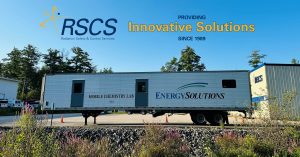
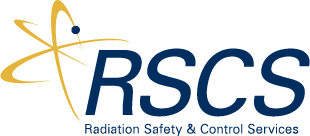
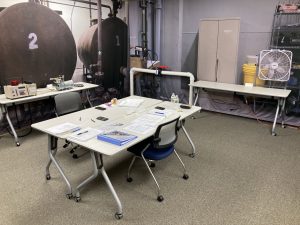
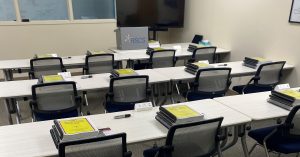
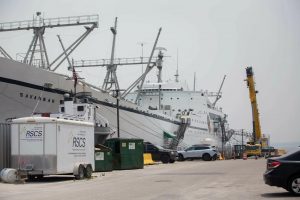
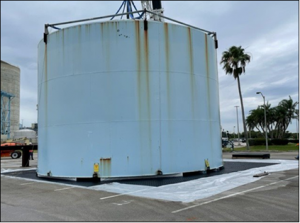
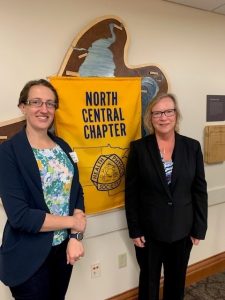 Ellen Anderson, Director of Radiological Services, was chosen to make the 2023 Wissink Memorial Lecture at the 54th Northern Central Chapter of the Health Physics Society meeting on April 21st, in Madison Wisconsin. This annual lectureship memorializes Robert Wissink’s lifelong service and contributions to health physics and the North Central Chapter.
Ellen Anderson, Director of Radiological Services, was chosen to make the 2023 Wissink Memorial Lecture at the 54th Northern Central Chapter of the Health Physics Society meeting on April 21st, in Madison Wisconsin. This annual lectureship memorializes Robert Wissink’s lifelong service and contributions to health physics and the North Central Chapter.